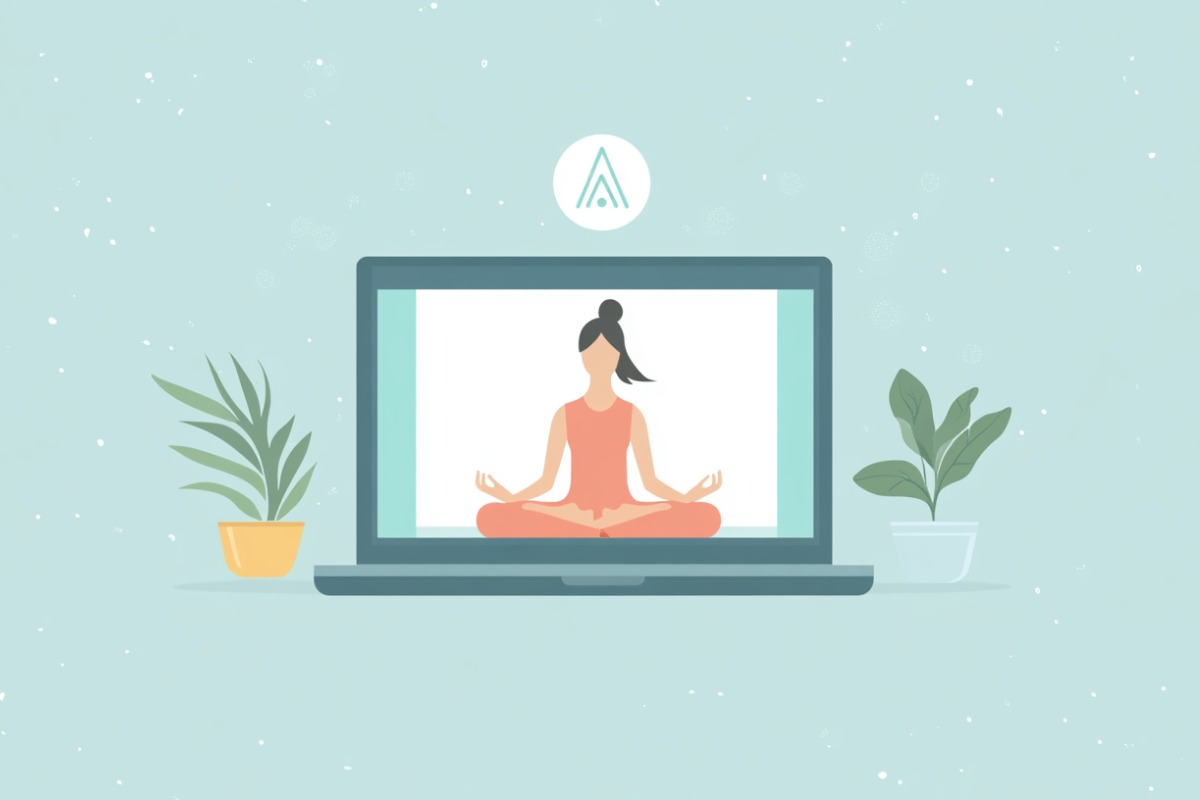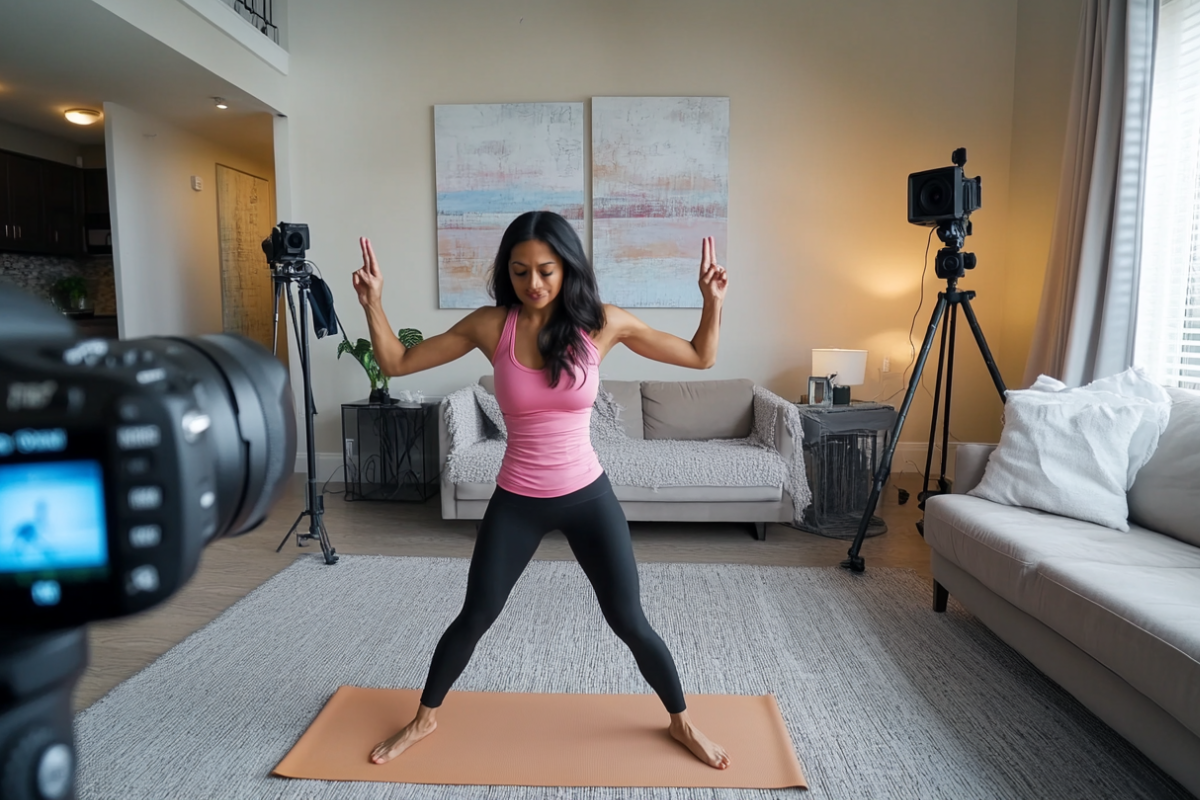How to teach Yoga online

How to teach Yoga online? This will cover everything you need to know – from setting up your virtual studio to teaching remotely.
Teach yoga online to reach more people, offer flexible learning options and create multiple income streams. Choose your platform and let’s get started!

Key
Takeaways
- Teaching yoga online expands your reach globally, offering flexibility and convenience for students and teachers.
- High-quality equipment, a clean teaching space, and proper setup/testing are essential for a professional experience.
- The choice of platform (Zoom, YouTube, Facebook Live, etc.) significantly impacts the effectiveness of your online classes.
- Building an engaging online presence through social media and email marketing helps attract and retain students.
- Diversify your offerings with live-stream classes, on-demand sessions, workshops, and themed content.
- Flexible pricing models and membership options cater to a wide range of students and ensure steady income streams.
- Strategic marketing, including free trials and partnerships, can effectively grow your online yoga business.
- Addressing technical challenges proactively ensures a smooth experience for students and teachers.
- Interactive and personalized teaching methods foster stronger engagement and a sense of community.
- Learn from successful online yoga businesses to develop unique and effective strategies.
- Stay adaptable and continuously improve your methods to thrive in the digital yoga teaching space.
Why teach online?
Consider teaching through an online yoga school, where you’ll find unparalleled flexibility and reach. By breaking geographical boundaries, your classes can reach students worldwide.
On-demand classes allow learners to fit their yoga practice into their busy schedules as they can practice at a time that suits them.
Virtual yoga classes are becoming more popular because of their convenience and affordability. They offer flexible pricing and can reach diverse communities, it’s a no brainer in the yoga and wellness industry.
By doing so you’ll have multiple income streams – live sessions, on-demand content and online courses in your arsenal.
And economical benefits of not having a physical location – you can offer competitive pricing for online classes and make money through selling access multiple digital channels.
Going online gives you the tools to create your own brand and a global community united by a common interest—nurturing students across the globe through virtual teaching.
Setting up your virtual studio

Setting up your virtual yoga classes at an online yoga studio requires a few crucial steps to get your digital teaching started.
First and foremost, choosing a reliable streaming platform is key to ensure your virtual classes, are smooth and look professional.
Having a strong online presence with good branding and website design will help grow your local studio own virtual yoga studio community.
Try out sessions with friends or family to test your equipment and iron out any technical issues before you go live. Don’t get stuck in the perfection trap – launch your website and start teaching and then improve as you go.
To make sure students find value in attending virtually, you need to provide high quality videos with good lighting, correct camera framing, clear sound and an inviting background. Establishing a clear niche can differentiate a yoga business from competitors.
All these elements will make each session look professional while still engaging for students at home.
Equipment
Having the right equipment is crucial to deliver high quality online and yoga videos and classes. You’ll need a yoga mat, facebook groups, blocks, straps, a computer or mobile device, a webcam, a microphone and good lighting.
A smartphone can be enough to record classes but investing in a tripod, studio light and a good microphone will make a big difference in your yoga videos too.
Minimizing tech disruptions means preparing your equipment and testing connections before class. Editing software like Filmora or iMovie can help polish your recorded content to make it look more professional and engaging for your students.
Start with an iPhone and a tripod is a good and affordable way to begin teaching yoga online.
Creating your teaching space
When teaching online yoga classes you need to choose the right space, it will impact your focus and students engagement. Look for a space that’s easily accessible, clean and tidy with minimal distractions. A clean space will not only help you focus but also allows your students to focus on their practice.
Encourage your students in your online yoga classes to have a dedicated space for their practice and it will boost their motivation and commitment.
Creating your own online yoga studio helps yoga instructors to retain control over their teaching and business.
Choosing the right platforms for online Yoga classes
Choosing the right platform to host online yoga classes is key to a seamless and engaging experience for your online and yoga instructors and students. Popular services like Zoom, YouTube, Facebook and Instagram have their own advantages that cater to different teaching styles and student preferences.
You can offer live video sessions, pre-recorded classes or even audio only formats and many more ways to connect with your and yoga students anywhere.
Udemy, Marvelous and Crowdcast may have more features like scheduling tools, payment processing and hosting live events within an online course.
Udemy allows instructors to set their own prices for yoga classes and takes a commission from sales.
Marvelous allows you to create a complete online yoga studio with features like streaming and payments.
Uscreen provides 24/7 support and onboarding assistance for yoga instructors monetizing their content.
Crowdcast facilitates interaction during classes with integrated features such as polls and Q&A.
Browser based options like Google Meet is easy to use and navigate for both instructors and students. Also, Google Meet allows hosting classes for up to 100 participants without any time limit.
Choose your digital venue according to how you want to teach and it will help you create a complete and unique professional presence through an online yoga class.
Zoom
Zoom is a popular tool for yoga teachers to teach yoga online by offering live streaming sessions. It has free and paid options to cater to different instructor needs.
The free option allows up to 100 participants per session with 40 minute time limit which may not be enough for longer classes. Creating an account on Zoom is easy and all you need to do is to download the app.
The video feature of the platform makes interactive opportunities during online yoga sessions more dynamic and personalized.
Using a reliable service like Zoom will minimize tech disruptions in live yoga classes and create a smooth and efficient learning environment for teachers and students.
YouTube
YouTube is the most popular platform for teaching yoga online, known for its massive audience and interactive features.
Yoga teacher Brett Larkin prefers yoga. YouTube to teach her online yoga classes, she says it has a big audience and is flexible. You can host live classes without any limit on number of attendees and can stream up to 12 hours of sessions.
Once you have a big subscriber base, you can monetize your online yoga studio through ad revenue on YouTube. Subscription revenue creates strong, community-driven membership sites for yoga instructors.
The platform is also flexible to create a full virtual studio where you can have live sessions and pre-recorded content for different preferences of your students.
Facebook & Instagram live
Facebook and Instagram Live are great ways to go teach yoga online, you can have instant engagement with your audience.
With Facebook Live you can host up to 8 hours and on Instagram Live you can host up to 60 minutes per session, it’s important to increase your audience reach by growing your followers and notify them about your upcoming classes and live streams through notifications.
These online platforms will allow for interactive sessions online workshops where participants can comment, ask questions and get instant replies.
Such direct interaction will not only create an online community but also make live streaming yoga classes more enjoyable.
Online presence

Having an online presence is key for yoga teachers moving to virtual yoga studios. Creating an online community will fill the gap left by physical studios.
Connect with your audience on social media and share your personal stories to create a supportive and engaging online yoga community. Showcasing what students can achieve through your classes will increase the perceived value and attract new subscribers.
Retaining and growing your online yoga community means updating your video library, engaging with students and offering valuable resources.
Use existing students as brand ambassadors through referrals and offer exclusive content and events to keep paying customers engaged and loyal.
Social media engagement
Using social media platforms like Instagram and Facebook will increase your online business visibility and attract new students. By posting content that includes live sessions or behind the scenes of your business you will get more engagement from your followers and expand your reach.
It’s important for the growth of your yoga business to connect with these people by engaging with them through interactive posts that encourages them to get involved.
Partner with other influencers in yoga industry or nearby businesses to promote your yoga services to potential clients and expand your network.
Join online yoga communities and groups to increase awareness about yoga alliance what you offer within those communities.
Also read >>> Is Sacred Paths Yoga’s 200-hour online YTT right for you?
Email marketing
Having an email list is a way to stay in direct touch with your students and ensure consistency. Offering free resources or digital downloads is a great incentive for potential students to subscribe to your email.
Using personalized email marketing with valuable content will increase student engagement and retention. Keeping your audience updated and involved by announcing new classes and workshops via email is important. We use a Free Server: Mautic but Namastelight is also a very good paid option.
Yoga content
Having a diverse and interesting yoga content is the key to attracting and retaining students.
Offering different types of classes, Vinyasa, restorative, classes focused on specific themes or techniques will cater to different students and inject life into your offerings.
By trying different ways you will be able to create your own teaching style that truly connects with your students.
With online yoga courses you can create multi-week curricula for specific styles or goals. This gives students convenience and comprehensive learning and can be easily used at home by suggesting common household items as substitutes for studio props like firm pillows or big blocks.
The best online yoga teachers use their published content to share knowledge and attract new students to their teaching.
On-demand classes
Creating top-notch on-demand yoga content gives practitioners the flexibility to practice at their own pace and location, they get extraordinary flexibility.
Teachers can build a library of recorded sessions that students can access anytime they want and that will enrich their learning journey, see our articles listing the top streaming yoga platforms.
Using visual elements like short demos of flows and different yoga poses is a great way to grab your audience.
Engagement with on-demand yoga courses is increased by allowing students to pause, play back, fast forward or rewind the videos which makes the learning experience super interactive.
Creating content about different yoga poses shows your expertise and will attract potential students who may become followers.
Live-stream classes
When live-streaming classes, be authentic and personal by sharing your stories and tone will deepen your connection with your students.
Follow-along instruction will prevent students from having to juggle multiple tasks and allows voice-over guidance which makes the sessions more interactive and user-friendly.
It’s important for your live stream yoga class to be aware of the different levels of your students and provide adjustments and progressions accordingly.
Workshops and special sessions
Focusing on specific topics like stress relief or flexibility, themed workshops is a unique learning opportunity. Integrating themes into your teaching will keep students engaged and add extra value to your classes.
These workshops are flexible and covers a range of topics that will appeal to different tastes and will enrich the learning journey for all.
Pricing your online Yoga classes
When you launch your online yoga business online, you need to decide between free classes and paid classes. Think about the goals of your yoga business and the value you deliver when setting a fair price for your classes.
A suggested price range for online yoga sessions is $5-20 per session, it covers a wide range of practitioners.
Keep in mind that teachers have control over their prices on platforms like Udemy but they also need to consider the big fees charged by these platforms.
Translating brick and mortar studio rates to the digital world can be its own challenge. Having adjustable membership fee plans and different pricing strategies will lay the foundation for steady income.
By offering multiple options—whether through ongoing memberships, single transaction payments or pay-per-view— you’re catering to different customer preferences and different economic capacity. Read our article on How much a Yoga class cost here.
Business models
Teachers can have regular income by having multiple membership options.
Take Carol’s studio as an example. She has two types of membership: monthly and annual. Tools like MemberSpace allow her to control who sees her content and offer different payment structures like membership, single transaction or pay-per-view options.
Expanding your yoga business model to sell digital downloads, special workshops and exclusive classes will Amplify your income streams.
By building personal connection with your students and offering them personalized services and private content, you can supercharge their commitment and loyalty to your online yoga business.
Payment gateways
Having reliable payment gateways like Stripe is crucial for transactions within your online yoga business. By integrating these payment services with MemberSpace you can streamline the sign up and fee collection process and control access to classes.
Setting up these systems is easy, usually takes about 5 minutes and you can start accepting payments for your sessions.
Using comprehensive solutions like Acuity Scheduling will refine your workflow by combining appointment scheduling with transaction processing.
Payment options on online platforms like Thinkific which includes secure services from providers like PayPal and Stripe will give both teachers and students convenience and security.
Having a smooth and secure way to handle payments will improve the experience of your paying customers with your online yoga business.
Marketing your online Yoga business

Now that you have your online yoga studio set up, you need to focus on marketing to attract and retain students. A solid marketing strategy will increase the visibility of your yoga business online and connect with potential customers.
Using social media and sending newsletters about your yoga classes is a great way to let people know what you offer.
To attract new students, offer a few free or pay-what-you-can sessions as part of your marketing. Highlight what’s unique about your online yoga classes and share testimonials from current students to build trust and get more sign ups.
By doing promotional activities regularly you’ll grow an online yoga community around your own business name.
Social media
Running focused social media campaigns will increase engagement and attract new students to your online yoga classes.
You can live stream your yoga classes for free on these platforms and connect with students worldwide and showcase your teaching style.
By using Instagram, Facebook and YouTube for live streams and interactive sessions you’re expanding your reach. YouTube enables monetization of livestreams and videos, but requires a certain number of subscribers.
Using targeted ads on these channels will help you find specific groups that may be interested in your online yoga offerings and increase class visibility. Creating engaging content, partnering with influencers and creating interactive posts are ways to Amplify your online presence and build a strong online community around host online yoga classes.
By engaging with your followers through comments and direct messages and live streaming regularly will build connections within this community which is key to get members to participate actively.
Collaborations and partnerships
Partner with other yoga teachers and wellness experts like a yoga teacher can deepen the learning journey for those you teach and connect you with a wider range of potential students.
Partner with nearby gyms, health coaches, nutritionists and practitioners of complementary medicine will boost your credibility and add variety to your services.
By working together through joint workshops, dual led classes and co-branded online content with wellness brands you can tap into each other’s audience and expand your reach in online world.
Building relationships within the wellness community will not only add to what you have to offer but will give you a network of support that will give you critical insights and opportunities for growth.
Online Yoga teaching challenges
Technical issues and student engagement is part of the journey of teaching yoga online. But by using the right strategies and tools you can overcome these challenges and build a thriving online yoga studio.
Address the problems head on and you’ll have a better experience for yourself and your students practicing yoga online.
Technical issues
Issues like video feed interruptions, delayed sound and internet drop out can disrupt an online yoga class and be frustrating for both students and teachers.
To minimize these disruptions you need to have a stable internet connection and check your tech before classes and have contingency plans in place.
Being tech savvy and prepared will make the experience better for your online yoga students.
Student engagement
Student engagement in an online environment can be tough because there’s no face to face interaction and home distractions. Live groups build rapport and experience sharing and will increase enthusiasm and encourage participation.
Teachers benefit from these live groups as they can see students’ yoga poses closely and give immediate adjustments which adds to the interactivity of the class.
To engage students in online yoga classes you need to create a distraction free environment so students can focus on their yoga practice. Active engagement through interactive sessions and personalized commentary will increase student engagement and sense of community in the class.
Real life examples
New teachers can get inspiration and insights by looking at successful online yoga businesses. By looking at how these online studio businesses use MemberSpace you can launch your very own online yoga studio business and create a membership strategy.
My Yoga essence
Carol’s own online yoga studio My Yoga Essence is an example of a successful online yoga business. She has two membership options, annual or monthly, so students can join her own virtual yoga studio anywhere.
The upper tier membership includes monthly 1:1 sessions, twice monthly community circles and exclusive discounts, personalized guidance and sense of community for members.
Jaffer Yoga
Jaffer Yoga offers a unique way of practicing yoga through audio only sessions, for those who prefer a different way of engaging.
This allows practitioners to fit their yoga practice into their daily routine.
Jaffer Yoga offers a 30 day free trial for new students. This allows potential students to try the classes with no commitment and stay engaged with the program.
Conclusion
In summary teaching yoga online gives you flexibility, access to a larger audience and many income streams. You need to have a virtual yoga studio set up, choose the right platforms and create great content to build an online yoga business.
Promote your own classes, and navigate the usual problems and you’ll have an online yoga community and inspire students worldwide.
Don’t forget that teaching yoga online is an ongoing process of growth. Take every opportunity that comes your way, stay connected with your students and continually refine how you do things so you can always deliver the best to them.
With persistence and smart strategies you can take your yoga teaching career to new heights in the digital space.
FAQs
The pandemic pulled the rug out from under in-person yoga and the author had no choice but to roll out their mat online instead!
So get started and choose your streaming platform—it’s the first step to getting your online yoga business up and running!
Zoom was used for both group and private classes.
The author started recording with just an iPhone and a tripod—talk about low budget but high production value!
The author uses Acuity Scheduling for all her booking and payment needs—because who doesn’t love one stop shopping for scheduling?




